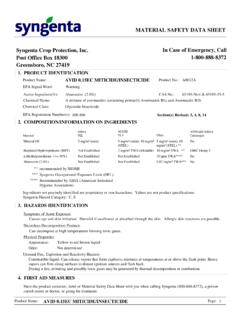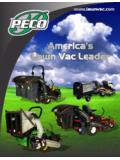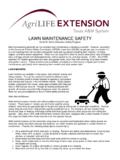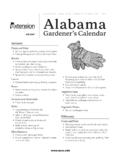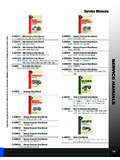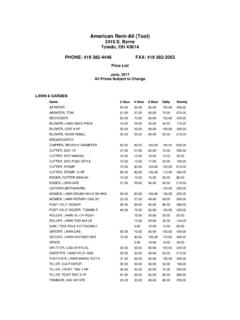Transcription of MATERIAL SAFETY DATA SHEET In Case of ... - Lawn & Garden
1 MATERIAL SAFETY DATA SHEET 1. CHEMICAL IDENTIFICATION 2. COMPOSITION/INFORMATION ON INGREDIENTS 3. HAZARDS IDENTIFICATION 4. FIRST AID MEASURESP roduct No.: A9793 BEPA Signal Word:CautionSymptoms of Acute ExposureExposure may cause eye, skin, or respiratory tract irritation. A skin (allergic) reaction may occur occasionally in some Decomposition ProductsNone KnownPhysical PropertiesAppearance:Golden Brown LiquidOdor:Sweet OdorUnusual Fire, Explosion and Reactivity HazardsThis product is an NFPA Class IIIB Combustible poisoning is suspected, immediately contact a physician, the nearest hospital, or the nearest Poison Control Center. Tell the person contacted the complete product name, and the type and amount of exposure. Describe any symptoms and follow the advice NOT INDUCE VOMITING.
2 If victim is fully conscious, immediately give a large quantity of water to drink and get medical attention. Never give anything by mouth to an unconscious rinse eyes with a large amount of running water. Hold eye lids apart to rinse the entire surface of the eyes and lids. Do not apply any medicating agents except on the advice of a Name:PENNANT MAGNUMI ngestion:Eye Contact: Syngenta Crop Protection, IncPost Office Box 18300In Case of Emergency, Call1-800-888-8372 Greensboro, NC 27419 CAS No.:87392-12-9 Chemical Name:Acetamide, 2-chloro-N-(2-ethyl-6-methylphenyl)-N-(2 -methoxy-1-methylethyl]-,(S)Chemical Class:Chloroacetanilide HerbicideActive Ingredient(%):S-Metolachlor ( ) MaterialNTP/IARC/OSHAC arcinogenOtherOSHAPELACGIHTLVNoPetroleum Solvent Not EstablishedNot EstablishedNot EstablishedNo Naphthalene10 ppm 10 ppm (STEL= 15 ppm) Not EstablishedNo 1,2,4-TrimethylbenzeneNot EstablishedNot EstablishedNot EstablishedNoS-Metolachlor ( ) Not EstablishedNot EstablishedNot EstablishedPage:1 Product Name: PENNANT MAGNUM 5.)
3 FIRE FIGHTING MEASURESWash with plenty of soap and water, including hair and under fingernails. Do not apply any medicating agents except on the advice of a physician. Remove contaminated clothing and decontaminate prior to victim from contaminated area to fresh air. Apply artificial respiration if to PhysicianMedical Condition Likely to be Aggravated by ExposureIndividuals with allergic history or pre-existing dermatitis should use extra care in handling this and ExplosionUnusual Fire, Explosion and Reactivity HazardsThis product is an NFPA Class IIIB Combustible Case of FireUse dry chemical, foam, or CO2 extinguishing media. Wear full protective clothing and self-contained breathing apparatus. Evacuate nonessential personnel from the area to prevent human exposure to fire, smoke, fumes or products of combustion.
4 Prevent use of contaminated buildings, area, and equipment until :Not Applicable>200 F (Setaflash) Lower: %; Upper: % Not Available Not AvailableFlash Point (Test Method):Flammable Limits (% in Air):Autoignition Temperature:Skin Contact:Inhalation: 6. ACCIDENTAL RELEASE MEASURES 7. HANDLING AND STORAGEIn Case of Spill or LeakStore the MATERIAL in a well-ventilated, secure area out of the reach of children and domestic animals. Do not store food, beverages or tobacco products in the storage area. Prevent eating, drinking, tobacco usage, and cosmetic application in areas where there is a potential for exposure to the MATERIAL . Always wash thoroughly after chemical SAFETY glasses with side shields or chemical goggles, rubber gloves, rubber boots, long-sleeved shirt, long pants, head covering, and a NIOSH-approved chemical cartridge respirator with organic vapor cartridges and either a P-100 or P-95 pre-filters or use a self-contained breathing apparatus (SCBA).
5 For small spills, cover the spill with an absorbent MATERIAL such as pet litter. Sweep up and place in an approved chemical container. Wash the spill area with water containing a strong detergent, absorb with pet litter or other absorbent MATERIAL , sweep up and place in a chemical container. Seal the container and handle in an approved manner. Flush the area with water to remove any residue. Do not allow wash water to contaminate water is no specific antidote if this product is reactions have been treated with antihistamines and ointments containing an anti-inflammatory of emesis is not recommended due to the large amount of petroleum solvent in this product, which could cause chemical pneumonitis if aspirated. If ingested, lavage stomach, taking care to avoid aspiration of stomach contents into the alert for compromised aqueous suspension of activated charcoal can be administered to absorb remaining toxicant.
6 8. EXPOSURE CONTROLS/PERSONAL PROTECTIONP revent eating, drinking, tobacco usage and cosmetic application in areas where there is a potential for exposure to the MATERIAL . Always wash thoroughly after avoid eye contact, wear SAFETY glasses with side shields or chemical :Eye Contact:THE FOLLOWING RECOMMENDATIONS FOR EXPOSURE CONTROLS/PERSONAL PROTECTION ARE INTENDED FOR THE MANUFACTURE, FORMULATION AND PACKAGING OF THE PRODUCT. FOR COMMERCIAL APPLICATIONS AND ON-FARM APPLICATIONS CONSULT THE PRODUCT :2 Product Name: PENNANT MAGNUM 11. TOXICOLOGICAL INFORMATIONA cute Toxicity/Irritation StudiesMutagenic PotentialReproductive Hazard PotentialChronic/Subchronic Toxicity StudiesCarcinogenic PotentialToxicity of Other ComponentsIngestion:Dermal:Inhalation:Ey e Contact:Skin Contact:Skin Sensitization:Slightly ToxicSlightly ToxicSlightly ToxicOral LD50 (Rat) : Moderately Irritating (Rabbit)Slightly Irritating (Rabbit)Sensitizing (Guinea Pig)Dermal LD50 (Rabbit) : Inhalation LC50 (Rat) : 3,425 mg/kg body weight> 2,000 mg/kg body weight> mg/l air - 4 hoursOther Toxicity InformationNot Available 9.
7 PHYSICAL AND CHEMICAL PROPERTIESG olden Brown LiquidSweet Odor 10. STABILITY AND REACTIVITYR eactivityStability:Stable Under Standard ConditionsHazardous Polymerization:Will Not OccurConditions to Avoid:None KnownHazardous Decomposition ProductsNone KnownMelting Point:Boiling Point:Specific Gravity/Density:Not ApplicableNot g/cc @ 20 CAppearance:Odor: (1% solution in H2O @ 25 C)Solubility in H2 OVapor PressureTo avoid skin contact, wear rubber gloves, rubber boots, long-sleeved shirt, long pants and a head avoid breathing spray or mist, wear a NIOSH-approved chemical cartridge respirator with organic vapor cartridges and either a P-100 or P-95 pre-filters or use a supplied-air Contact:Inhalation:S-Metolachlor:None ObservedS-Metolachlor:None ObservedS-Metolachlor:None ObservedS-Metolachlor.
8 Benign liver tumors at high dose levels (female rats).Eye contact causes irritation. Inhalation may cause irritation of eyes, nose and throat and dizziness. Skin contact Petroleum Solvent g/L @ 25 CS- mmHg @ 25 C:Page:3 Product Name: PENNANT MAGNUM 12. ECOLOGICAL INFORMATION 13. DISPOSAL CONSIDERATION 14. TRANSPORT INFORMATION 15. REGULATORY INFORMATIONDo not reuse product containers. Dispose of product containers, waste containers, and residues according to local, state, and federal health and environmental Waste:Under certain circumstances, discarded product may exhibit TCLP hazardous characteristics. A hazardous waste determination should be done on a case by case Waste:Not ApplicableDOT Classification:SURFACE Transportation:Non-Bulk (<119 gallon cap.): NOT regulated by DOTBulk (tank truck quantities): RQ Other regulated substances, liquid, (contains naphthalene), 9, NA3082, PGIIIAIR Transportation:Domestic and International: NOT regulated under IATAB/L Freight ClassificationHerbicides, NOII nternational Transportation(Water): Not ApplicableSARA Title III ClassificationSection 311/312:Summary of EffectsEnvironmental FateEco-Acute Toxicity DisposalTarget OrgansActive IngredientsInert IngredientsEco-Chronic ToxicityAcute Health HazardChronic Health Hazardmay cause dermatitis.
9 Ingestion may cause nausea and vomiting. Large amounts, if retained, lead to symptoms of central nervous system AvailableS-Metolachlor:No data available for the formulation. The information presented here is for the active ingredient, s-metolachlor. A thorough review of environmental information is not possible in this document. For additional information call the toll free number listed in Section PERSISTENCE/MOBILITY:Degrades on soil in the light (t1/2 ~ 95 d). Primary aerobic soil degradation (t1/2 ~ 9 d) is more rapid than secondary degradation (t1/2 = 68 d). Mobility classified as high to medium in various soils (Koc = 110 to 369).S-Metolachlor:S-Metolachlor:Not Available S-MetolachlorLiver:Petroleum Solvent:Eyes, Skin, Respiratory Tract and Central Nervous SystemS-Metolachlor:Not Available Page:4 Product Name: PENNANT MAGNUMP roposition 65 Not ApplicableRCRA ClassificationUnder certain circumstances, discarded product may exhibit TCLP hazardous characteristics.
10 A hazardous waste determination should be done on a case by case StatusExempt from TSCA, subject to FIFRAS ection 313 chemical(s): 16. OTHER INFORMATIONNFPA Hazard Ratings1103/30/19986/28/20003/13/2000 Health:Flammability:Reactivity:Supersede s:Issued Date:Revised Date:CERCLA Reportable Quantity (RQ)14,814 lbs. (Based on Naphthalene [RQ=100 lbs] content in formulation)RSVP# : SCP-955-00225B The information and recommendations contained herein are based upon data believed to be correct. However, no guarantee or warranty of any kind, expressed or implied, is made with respect to the information contained herein. 0 Least 1 Slight 2 Moderate 3 High 4 Severe 1,2,4-Trimethylbenzene (CAS No. 95-63-6) Naphthalene (CAS No. 91-20-3)Questions concerning the safe handling of the product should be referred to:1-800-334-9481 Page:5 Product Name: PENNANT MAGNUM





